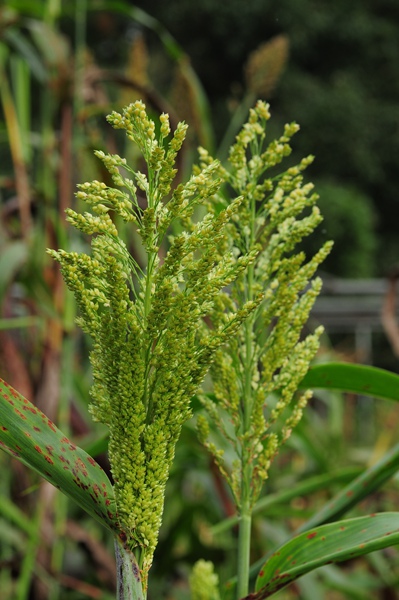
- Scientific Name: Sorghum bicolor (L.) Moench
- Ref: Methodus:207. 1794
- Synonyms:
- Agrostis nigricans (Ruiz & Pav.) Poir.
- Andropogon besseri Kunth
- A. bicolor (L.) Roxb.
- A. compactus Brot.
- A. niger (Ard.) Kunth
- A. rubens (Gaertn.) Kunth
- A. saccharatus (Willd.) Roxb.
- A. sorghum (L.) Brot.
- A. subglabrescens Steud.
- A. truchmenorum Walp.
- A. usorum Steud.
- A. vulgaris Raspail
- Holcus albus Steud.
- H. arduinoi J.F.Gmel.
- H. bicolor L.
- H. cafer Ard.
- H. caffrorum (Retz.) Thunb.
- H. cernuus Ard.
- H. compactus Lam.
- H. dochna Forssk.
- H. dora Mieg
- H. duna J.F.Gmel.
- H. durra Forssk.
- H. ferrugineus Schrad. ex Roem. & Schult.
- H. niger Ard.
- H. nigerrimus Ard.
- H. nigricans Steud.
- H. pyramidalis Steud.
- H. rubens Gaertn.
- H. saccharatus L.
- H. sorghum L.
- Milium bicolor (L.) Cav.
- M. compactum (Lam.) Cav.
- M. maximum Cav.
- M. nigricans Ruiz & Pav.
- M. sorghum (L.) Cav.
- M. sorgo Garsault
- Panicum caffrorum Retz.
- P. frumentaceum Salisb.
- P. sacchariferum Salisb.
- Rhaphis sorghum (L.) Roberty
- Sorghum abyssinicum (Hack.) Chiov.
- S. album Roem. & Schult.
- S. ankolib (Hack.) Stapf
- S. anomalum Desv.
- S. arduinoi (J.F.Gmel.) J.Jacq.
- S. basiplicatum Chiov.
- S. basutorum Snowden
- S. caffrorum (Retz.) P.Beauv.
- S. campanum Ten. & Guss.
- S. caudatum (Hack.) Stapf
- S. centroplicatum Chiov.
- S. commune P.Beauv.
- S. compactum Lag.
- S. conspicuum Snowden
- S. coriaceum Snowden
- S. dochna (Forssk.) Snowden
- S. dulcicaule Snowden
- S. durra (Forssk.) Trab.
- S. elegans (Körn.) Snowden
- S. eplicatum Chiov.
- S. exsertum Snowden
- S. gambicum Snowden
- S. giganteum Edgew.
- S. glycychylum Pass.
- S. guineense Stapf
- S. japonicum (Hack.) Roshev.
- S. margaritiferum Stapf
- S. medioplicatum Chiov.
- S. melaleucum Stapf
- S. melanocarpum Huber
- S. mellitum Snowden
- S. membranaceum Chiov.
- S. miliiforme (Hack.) Snowden
- S. nankinense Huber
- S. negrosense Nesom
- S. nervosum Chiov.
- S. nigericum P.Vig.
- S. nigricans (Ruiz & Pav.) Snowden
- S. nigrum (Ard.) Roem. & Schult.
- S. notabile Snowden
- S. pallidum Chiov.
- S. papyrascens Stapf
- S. pyramidale Roem. & Schult.
- S. rigidum Snowden
- S. rollii Chiov.
- S. roxburghii Stapf
- S. rubens Willd.
- S. saccharatum (L.) Moench
- S. sativum (Hack.) Trab.
- S. schimperi (Hack.) Chiov.
- S. simulans Snowden
- S. splendidum (Hack.) Snowden
- S. subglabrescens (Steud.) Schweinf. & Asch.
- S. tataricum Huber
- S. technicum (Körn.) Trab.
- S. thonizzii Pasq.
- S. truchmenorum K.Koch
- S. usorum Nees
- S. vulgare Pers.
- English Common Name: sorghum, great millet, durra, jowari, milo
- Chinese Common Name: 高粱 gāoliáng, 蜀黍 shǔshǔ
- Japanese Common Name: モロコシ [蜀黍/唐黍] morokoshi
- Family: Poaceae
- Genus: Sorghum
- Distribution: Cultivated in China [native to Africa; widely cultivated in the tropics].
Annual. Culms erect, robust, 3–5 m tall, 2–5 cm in diam.; nodes glabrous or pubescent. Leaf sheaths glabrous or slightly farinose; leaf blades linear or linear-lanceolate, 40–70 × 3–8 cm, glabrous; ligule subrounded, ciliate. Panicle very variable, lax or dense, cylindrical or pyramidal to obovate in outline, up to 60 cm, main axis elongate to very short; primary branches ascending or spreading, lower branches sometimes almost as long as panicle, stiff or pendulous; racemes tough at maturity, composed of 2–6 spikelet pairs. Sessile spikelet variable, broadly obovate to subglobose, 3.5–5.5 mm; callus hispid; lower glume leathery to papery, glabrous to pilose, pale creamy-green to dark brown or blackish at maturity, upper lemma usually awned; awn 0.4–1.5 cm. Pedicelled spikelet male or barren, linear-lanceolate, persistent or deciduous. Caryopsis large, often exposed between the gaping glumes. Fl. and fr. Jun–Sep. 2n = 20. (Flora of China)
